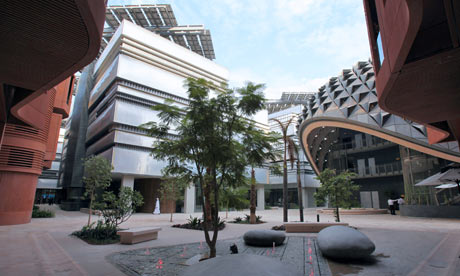Green building does not always require the latest in smart grid technology, solar panels, expensive recycled materials or the manipulation of Leed scores for environmental design in the same way students study tactically for standardised university examinations. Architects and designers across the globe are channelling their ancestors and creating building plans that maximise air flow, mitigate their impact on the local environment and offer comfort to residents and workers. Creative solo designers and architectural firms who understand traditional elements of design can add impressive projects to their portfolios without reinventing construction methods.
Masdar, the United Arab Emirate's ambitious eco-city a short drive from Abu Dhabi's international airport, is at the forefront of sustainable development in the Arabian Peninsula. Inside the campus buildings, soon to be home to Siemens' regional headquarters, are graduate students and scientists working on cutting edge research. They are protected on the outside, however, by architectural features that have protected residents for centuries. Narrow streets accelerate air flow, and those same pathways cut at sudden angles to protect pedestrians from the searing summer heat. Thick walls help keep interiors cool. In the middle of a courtyard is a massive wind tower that siphons hot air from above and turns it into a cool breeze that relieves residents taking a break in the shady courtyard below. Windows are protected with materials reminiscent of palm fronds that performed the same function in older homes and buildings. Other new developments in the region, from Katara in Doha to Kaust University in Saudi Arabia, rely on similar techniques to reduce energy and water consumption.
In the Far East, the venerable construction firm Takenaka has run a green construction practice in Japan for more than 40 years. The company adopted a framework, Sustainable Works, that it uses when consulting clients. The firm's innovation harkens back to an era when Japanese builders had no choice but to be as efficient as possible with their use of resources. Takenaka, of course, often incorporates aesthetics such as clean lines into its plans, but also allows buildings to contour with their natural environments. Woods sourced locally, or even recycled, are implemented in building anything from shopping malls to sporting facilities. Thin curtains in office buildings are reminders of shoji, thin paper that allows in light while keeping out heat. And just as traditional Japanese structures had one main room that could be used for various purposes, many of Takenaka's designs permit spaces to have multiple uses. The elimination of bearing walls and beams reduces the amount of building materials necessary for such projects. Balconies with movable louvres are another feature that allows air to circulate freely, necessary between Japan's humid summers and the strain on the country's electrical grid in the aftermath of Fukushima.
For centuries, Native Americans in the US south-west used rammed earth construction to build their houses to cope with scorching summers and chilly winter nights. The technique involves tampering a mixture of clay and sand into building blocks. Once built, the rammed-earth structures smooth out sharp temperature fluctuations between day and night typical in the Arizona and New Mexico landscapes. One Northern California designer, David Easton, has fine-tuned the process for the homes he has built in California and Hawaii. Rammed earth is also used in traditional Chinese and African construction. It rebounded in popularity in the 1970s but quickly became expensive. Easton works with his clients to develop new processes to keep costs down.
Traditional building applications can cross borders and continents. Brazilian architect Marcio Kogan added a traditional Arabic flair to his Bahia's House in Salvador, Brazil. In addition to the structure's wide open floor plan, which promotes ventilation, Kogan included Mashrabiya windows in his design; the sophisticated latticework of the projecting oriel window provides shade during Bahia's steamy summers while permitting cool air to filter in from the street. Regardless of where an architect and home builder is based, our ancestors around the world have provided us with plenty of past examples to build for a more sustainable and comfortable present.
Leon Kaye is founder and editor of GreenGoPost.com
This content is brought to you by Guardian Professional. Become a GSB member to get more stories like this direct to your inbox











